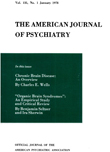MARSILID (IPRONIAZID) AND ELECTROSHOCK
Abstract
Marsilid (iproniazid), so far, is the only drug with powerful anti-depressive properties. Twenty-five out of 32 patients derived benefit from the drug. It is helpful [See TABLE-1 in source PDF] in depressive syndromes in which somatization and retardation predominate, particularly so, if strong neurotic features are present. In one severe chronic schizophrenic syndrome Marsilid had a powerful euphorizing, unblocking effect. It is ineffective in most agitated depressions. It requires considerable length of time before exerting effect. Half of the successfully treated patients relapsed and had to be kept on maintenance therapy.
Toxic features are of considerable degree and frequency. Fifteen out of 32 patients showed serious complications, among them 7 cases of liver damage. The well-known minor complications occurred in the vast majority of patients.
Indications for electroshock and Marsilid will rarely overlap since depressions with neurotic features were never a first choice indication for electroshock, and since the prevalent group of psychotic depressions, the agitated depressions, failed to respond to Marsilid. It appears that the anti-depressive effect of Marsilid is exerted over the sense of increased physical well-being and increased energy induced by the drug. A possibly important chance observation was the disappearance of the manifestations of psoriasis of 40 years uninterrupted duration and their reappearance after discontinuation of the drug. [See TABLE-2 in souce PDF]
Access content
To read the fulltext, please use one of the options below to sign in or purchase access.- Personal login
- Institutional Login
- Sign in via OpenAthens
- Register for access
-
Please login/register if you wish to pair your device and check access availability.
Not a subscriber?
PsychiatryOnline subscription options offer access to the DSM-5 library, books, journals, CME, and patient resources. This all-in-one virtual library provides psychiatrists and mental health professionals with key resources for diagnosis, treatment, research, and professional development.
Need more help? PsychiatryOnline Customer Service may be reached by emailing [email protected] or by calling 800-368-5777 (in the U.S.) or 703-907-7322 (outside the U.S.).



